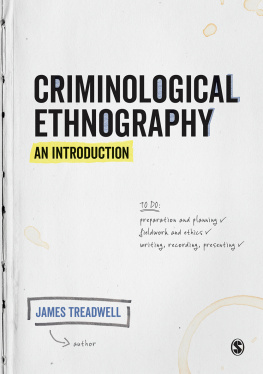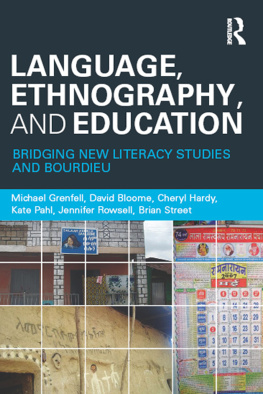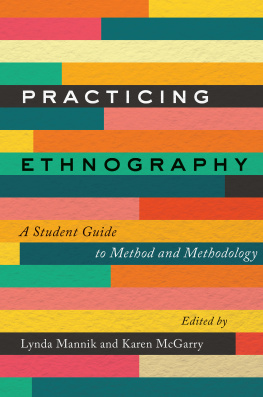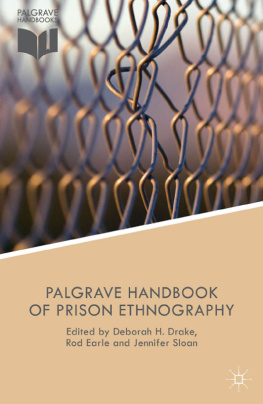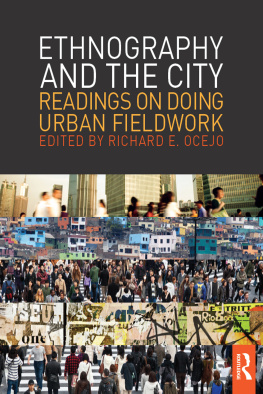Copyright 2014 University of Pennsylvania Press
All rights reserved. Except for brief quotations used for purposes of review or scholarly citation, none of this book may be reproduced in any form by any means without written permission from the publisher.
Published by
University of Pennsylvania Press
Philadelphia, Pennsylvania 19104-4112
www.upenn.edu/pennpress
Printed in the United States of America on acid-free paper
10 9 8 7 6 5 4 3 2 1
Library of Congress Cataloging-in-Publication Data
Sanjek, Roger, 1944
Ethnography in todays world : color full before color blind / Roger Sanjek.1st ed.
p. cm. (Haney foundation series)
Includes bibliographical references and index.
ISBN 978-0-8122-4545-5 (hardcover : alk. paper)
1. EthnologyUnited StatesMethodology. 2. EthnologyMethodology.
3. AnthropologyUnited StatesMethodology. 4. AnthropologyMethodology.
I. Title.
GN345.S255 2014
305.800973dc23
2013019444
For my teachers: Anne Schwerner, Robert Stigler,
Marvin Harris, Lambros Comitas, Jaap van Velsen,
George C. Bond, Allen JohnsonPreface
This book might have been titled For Ethnography! or, alternatively, Ethnography for What? Throughout, it aims to affirm the value of ethnography in engaging contemporary issues of race, migration, political activism, and an urbanizing globe. It includes as well essays examining this distinctive anthropological fieldwork methodethnography, or participant observationwhich its practitioners use to understand particular groups and places. And last, it asserts that ethnography is inescapably lodged in the social worlds of those who use it: first, as they decide what to study; then, how to do it; and finally, how to engage various publics with their findings.
The essays, now revised, were originally composed during the last decade of the twentieth century and the first decade of the twenty-first. They build upon and extend ideas and arguments contained in my books Fieldnotes: The Makings of Anthropology (1990), The Future of Us All: Race and Neighborhood Politics in New York City (1998), and Gray Panthers (2009). They also reflect the journey of an anthropologist who entered the field when it was undergoing tumultuous change in the 1960s, who moved from fieldwork abroad in Brazil and Ghana to long-term engagements in his own society, and who, after weathering theoretical storms in ensuing decades, now values ethnography even more than when he began.
Engaging Ethnography
The books first part, Engaging Ethnography, contains three chapters about fieldwork in New York Citys Elmhurst-Corona district. first presented as a talk to a multidisciplinary scholarly audience at the Russell Sage Foundation (which included sociologist Robert Merton, who, gratifyingly, told me that he enjoyed it). It was later published in the American Anthropologist, and here all demographic figures and projections are updated with more recent information.
This essay illustrates the doing of ethnography as this process is defined and historicized in (The Ethnographic Present), might be, in this case in perhaps the most ethnically mixed community in the world. The background sections about Elmhurst-Corona in the 1970s, before my fieldwork began in 1983, illustrate the importance of historical contextualization (more of this occurs in The Future of Us All). The significance of women leaders in these neighborhoods is what I found there on the ground, although a feminist perspective no doubt ensured that I deliberately paid attention to both men and women (as I had in earlier fieldwork in Ghana and did from the 1970s onward as a Gray Panther participant). The lesson I draw about the importance of inclusive color full before color blind political action is also a fieldwork-derived conclusion. Indeed, had I done my fieldwork in this neighborhood ten years earlier, my findings on both scores would have been quite different.
, The Organization of Festivals and Ceremonies among Americans and Immigrants in Queens, New York, was also written for a multidisciplinary academic audience, this time in Sweden, and halfway through my 19831996 Elmhurst-Corona fieldwork. The framework of four contrasting categories of local ritual events emerged while I was sitting in a Houston airport in 1988a fieldwork-derived theory of significance that then led me to attend as many of these events as I could. I had not anticipated the range and degree of public ritual activity I encountered, and my Queens College students who later read this essay, most from similar or even these same neighborhoods, were surprised as well.
This chapter also illustrates the comparative and theoretical side of ritual efflorescence following racial change, immigration, and fiscal crisis in Queens with greater focus and coherence.
, What Ethnographies Leave Out, answered a request from the editor of Xcp: Cross-Cultural Poetics, Mark Nowak. He asked for a contribution to a special issue on Fieldnotes and Notebooks, and what he wanted, I realized, was something less conventionally academic. The two fieldnote episodes I proposed, of a revival at a Protestant church I was studying and international day at an elementary school, had struck me with their short-storylike ironies when they occurred. I knew I was not the person to attempt to recast them in that genre, but Mark agreed that on their own they were suitable for his journal issue.
In this books context, these events show what raw notes from the field look like. Many of my Queens College students who read this pieceof diverse religious and cultural backgrounds, many from immigrant familiesfound the revival unfamiliar and remote, but not the international day events: most had participated in similar rituals of inclusion themselves.
Ethnography, Past and Present
The second section, Ethnography, Past and Present, moves away from fieldwork in Queens to the distinctive features and history of ethnography.
Like most of this volumes essays, )
The standard color-blind history of ethnography needs rewriting, and since
, The Ethnographic Present, first appeared in a leading British anthropology journal (Man: The Journal of the Royal Anthropological Institute), and as Queens College students often reminded me, it is written in the most academic in-group style and format of the essays in this volume. Responding to the impact of 1980s postmodernism, it affirms the centrality of ethnography for an anthropology of the present. The essays in the first, third, and fourth sections of this book are intended to illustrate this.
As
Postmodern anthropology, and Clifford and Marcuss Writing Culture (1986) in particular, provoked, inspired, and rankled. Fieldnotes, as well as Localizing Strategies


